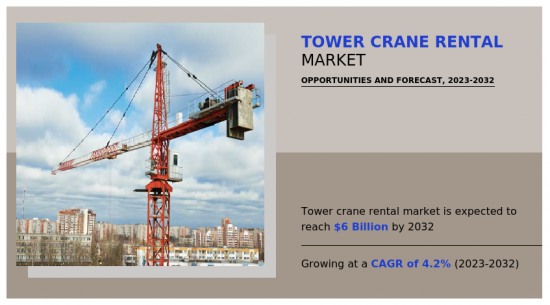
|
시장보고서
상품코드
1344383
타워 크레인 렌탈 시장 : 유형별, 용량별, 최종사용자별 - 세계 기회 분석 및 산업 예측(2023-2032년)Tower Crane Rental Market By Type, By Capacity, By End User : Global Opportunity Analysis and Industry Forecast, 2023-2032 |
||||||
Allied Market Research가 발행한 최신 보고서 '타워 크레인 렌탈 시장'에 따르면, 건설 및 제조 부문의 시장 수요 증가로 인해 2020년부터 2032년까지 4.2%의 높은 성장률을 보일 것으로 예상됩니다.

타워 크레인은 고가이기 때문에 일상적으로 필요하지 않은 소비자는 구매보다 대여를 선택해야 합니다. 또한 모든 소비자가 이러한 고가의 장비를 구입할 수있는 것은 아닙니다. 또한 많은 고객이 장비를 구입하기 위해 고금리 대출을받을 수있는 충분한 자금이 없을 수도 있습니다. 또한 경제적 제약으로 인해 모든 기계를 구입할 수 있는 것은 아닙니다. 그러나 필요할 때 임대함으로써 장비 비용을 절감하고 다른 프로젝트에 자금을 투입할 수 있습니다.
그러나 북미와 유럽 선진국에서는 이미 구축된 인프라, 최근 산업 붕괴, 높은 개발 비용 등으로 인해 신규 건설 활동이 포화상태에 이르렀습니다. 이에 따라 신규 건설 프로젝트에 대한 투자가 감소하여 선진국의 타워 크레인 렌탈 시장 확대가 억제될 것으로 예상됩니다.
한편, 대형 크레인은 대여가 가능하고, 해체도 용이하며, 새로운 건설 현장으로의 이동이 편리합니다. 또한 건설 중장비에 내장된 IoT와 같은 최신 기술 덕분에 렌탈 사업자는 장비의 위치와 작동을 쉽게 추적할 수 있습니다. 사물인터넷(IoT)은 자격을 갖춘 근로자 부족을 해결하고, 작업의 정확성을 높이고, 납기와 예산을 보장하며, 장비 안전 문제를 해결하는 데 도움이 될 수 있습니다. 그 결과, 예측 기간 동안 인터넷에 연결된 새로운 장비의 도입은 타워 크레인 시장 성장에 박차를 가할 것으로 예상됩니다.
목차
제1장 서론
제2장 주요 요약
제3장 시장 개요
- 시장 정의와 범위
- 주요 조사 결과
- 영향요인
- 주요 투자 기회
- Porter's Five Forces 분석
- 시장 역학
- 성장 촉진요인
- 개발도상국의 건설 활동 급증
- 유지보수 비용, 인건비, 운영 비용 등의 경비 절감
- 높은 소유 비용과 재정적 제약이 없다
- 성장 억제요인
- 숙련된 유자격 오퍼레이터 부족
- 선진국의 신규 건설 활동 감소
- 기회
- IoT 기술에 의한 이전 용이성과 높은 효율성
- 성장 촉진요인
- COVID-19에 의한 시장에 대한 영향 분석
제4장 타워 크레인 렌탈 시장 : 유형별
- 자주식
- 라핑지브
- 해머 헤드
- 플랫톱
제5장 타워 크레인 렌탈 시장 : 용량별
- 5톤 미만
- 6톤 이상 10톤 미만
- 10톤 이상
제6장 타워 크레인 렌탈 시장 : 최종사용자별
- 건설 및 인프라
- 광업
- 에너지
- 기타
제7장 타워 크레인 렌탈 시장 : 지역별
- 북미
- 미국
- 캐나다
- 멕시코
- 유럽
- 독일
- 프랑스
- 영국
- 이탈리아
- 기타 유럽
- 아시아태평양
- 중국
- 일본
- 한국
- 인도
- 기타 아시아태평양
- 라틴아메리카
- 라틴아메리카
- 중동
- 남아프리카공화국
제8장 경쟁 상황
- 서론
- 주요 성공 전략
- 주요 10개사 제품 매핑
- 경쟁 대시보드
- 경쟁 히트맵
- 주요 기업 2020년 포지셔닝
제9장 기업 개요
- Bigge Crane & Rigging Co.
- Action Construction Equipment
- titan cranes & rigging
- leavitt cranes
- Zoomlion ElectroMech India Pvt. Ltd
- WASEL Gmbh
- All Tower Crane
- Skycrane
- Falcon Tower Crane Service
- L.P. Crane
The Tower crane rental market is likely to experience a significant growth rate of 4.2% from 2020-2032 owing to increasing market demand from construction and manufacturing sector - Allied Market Research

Owing to the high cost of heavy towers, consumers who do not require the equipment on a daily basis need to choose to rent it rather than buy it. In addition, not all consumers have the ability to afford such expensive equipment. Furthermore, many clients may not have sufficient funds to obtain a loan with a higher interest rate to purchase equipment. Moreover, due to financial restrictions, not all machines can be bought by clients. However, renting one, when necessary, might cut costs for the equipment and allow funds to be redirected to other projects, which spurs the expansion of the global market.
However, in developed countries of North America and Europe, there is a saturation of new construction activities due to the already constructed infrastructure, the recent industrial collapse, and the high cost of development. As a result, substantial investments in brand-new building projects have declined, which is anticipated to eventually constrain expansion of the market for renting tower cranes in developed countries.
On the other hand, large cranes are available for rent, simple to disassemble, and convenient to move to new construction sites. In addition, rental businesses can now easily follow the locations and operations of equipment, thanks to modern technologies such as IoT embedded in heavy construction equipment. The Internet of Things (IoT) assists in addressing a lack of qualified labor, increases work accuracy, ensures on-time & budget delivery, and addresses equipment safety concerns. As a result, during the projection period, the introduction of new internet-connected equipment is anticipated to spur market growth rented tower cranes.
The tower cranes market is segmented into type, capacity, application, and region. By type, the market is classified into self-erecting, luffing jib, hammer head, and flat top. The hammer head segment dominated the market in 2022. By capacity, the market is divided into less than 5 ton, 6 to 10 ton, and more than 10 ton. The less than 5 ton segment dominated the market in 2022. By application, it is categorized into construction & infrastructure, mining, energy, and others. The construction & infrastructure segment dominated the market in 2022.
Region wise, the market is analyzed across North America (the U.S., Canada, and Mexico), Europe (Germany, the UK, France, Italy, and rest of Europe), Asia-Pacific (China, India, Japan, South Korea, and rest of Asia-Pacific), and LAMEA (Latin America, Middle East, and Africa).
In 2022, Asia-Pacific was the key shareholder, however, LAMEA is anticipated to secure a leading position during the forecast period.
COMPETITION ANALYSIS
Key companies profiled in the tower crane rental market report include: Bigge Crane & Rigging Co., L.P. Crane, Action Construction Equipment, titan cranes & rigging, Falcon Tower Crane Service, Skycrane, leavitt cranes, All Tower Crane, WASEL Gmbh. and Zoomlion ElectroMech India Pvt. Ltd. Major companies in the market have adopted acquisition, product launch, business expansion, and other strategies as their key developmental strategies to offer better products and services to customers in the tower crane rental market.
Key Benefits For Stakeholders
- This report provides a quantitative analysis of the market segments, current trends, estimations, and dynamics of the tower crane rental market analysis from 2020 to 2032 to identify the prevailing tower crane rental market opportunities.
- The market research is offered along with information related to key drivers, restraints, and opportunities.
- Porter's five forces analysis highlights the potency of buyers and suppliers to enable stakeholders make profit-oriented business decisions and strengthen their supplier-buyer network.
- In-depth analysis of the tower crane rental market segmentation assists to determine the prevailing market opportunities.
- Major countries in each region are mapped according to their revenue contribution to the global market.
- Market player positioning facilitates benchmarking and provides a clear understanding of the present position of the market players.
- The report includes the analysis of the regional as well as global tower crane rental market trends, key players, market segments, application areas, and market growth strategies.
Key Market Segments
By Type
- Self-Erecting
- Luffing Jib
- Hammer Head
- Flat Top
By Capacity
- Less Than 5 Ton
- 6 to 10 Ton
- More Than 10 Ton
By End User
- Construction and Infrastructure
- Mining
- Energy
- Others
By Region
- North America
- U.S.
- Canada
- Mexico
- Europe
- Germany
- France
- UK
- Italy
- Rest of Europe
- Asia-Pacific
- China
- Japan
- South Korea
- India
- Rest of Asia-Pacific
- LAMEA
- Latin America
- Middle East
- South Africa
Key Market Players:
- Action Construction Equipment
- All Tower Crane
- Bigge Crane & Rigging Co.
- Falcon Tower Crane Service
- leavitt cranes
- L.P. Crane
- Skycrane
- titan cranes & rigging
- WASEL Gmbh
- Zoomlion ElectroMech India Pvt. Ltd
TABLE OF CONTENTS
CHAPTER 1: INTRODUCTION
- 1.1. Report description
- 1.2. Key market segments
- 1.3. Key benefits to the stakeholders
- 1.4. Research Methodology
- 1.4.1. Primary research
- 1.4.2. Secondary research
- 1.4.3. Analyst tools and models
CHAPTER 2: EXECUTIVE SUMMARY
- 2.1. CXO Perspective
CHAPTER 3: MARKET OVERVIEW
- 3.1. Market definition and scope
- 3.2. Key findings
- 3.2.1. Top impacting factors
- 3.2.2. Top investment pockets
- 3.3. Porter's five forces analysis
- 3.3.1. Low bargaining power of suppliers
- 3.3.2. Low threat of new entrants
- 3.3.3. Low threat of substitutes
- 3.3.4. Low intensity of rivalry
- 3.3.5. Low bargaining power of buyers
- 3.4. Market dynamics
- 3.4.1. Drivers
- 3.4.1.1. Surge in construction activities in developing countries
- 3.4.1.2. Reduction of expenses such as maintenance cost, labor cost, and operational costs
- 3.4.1.3. No high ownership cost & financial constraints
- 3.4.1. Drivers
- 3.4.2. Restraints
- 3.4.2.1. Lack of skilled and qualified operators
- 3.4.2.2. Decrease in new construction activities in developed nations
- 3.4.3. Opportunities
- 3.4.3.1. Ease of relocation and high efficiency with IoT technology
- 3.5. COVID-19 Impact Analysis on the market
CHAPTER 4: TOWER CRANE RENTAL MARKET, BY TYPE
- 4.1. Overview
- 4.1.1. Market size and forecast
- 4.2. Self-Erecting
- 4.2.1. Key market trends, growth factors and opportunities
- 4.2.2. Market size and forecast, by region
- 4.2.3. Market share analysis by country
- 4.3. Luffing Jib
- 4.3.1. Key market trends, growth factors and opportunities
- 4.3.2. Market size and forecast, by region
- 4.3.3. Market share analysis by country
- 4.4. Hammer Head
- 4.4.1. Key market trends, growth factors and opportunities
- 4.4.2. Market size and forecast, by region
- 4.4.3. Market share analysis by country
- 4.5. Flat Top
- 4.5.1. Key market trends, growth factors and opportunities
- 4.5.2. Market size and forecast, by region
- 4.5.3. Market share analysis by country
CHAPTER 5: TOWER CRANE RENTAL MARKET, BY CAPACITY
- 5.1. Overview
- 5.1.1. Market size and forecast
- 5.2. Less Than 5 Ton
- 5.2.1. Key market trends, growth factors and opportunities
- 5.2.2. Market size and forecast, by region
- 5.2.3. Market share analysis by country
- 5.3. 6 to 10 Ton
- 5.3.1. Key market trends, growth factors and opportunities
- 5.3.2. Market size and forecast, by region
- 5.3.3. Market share analysis by country
- 5.4. More Than 10 Ton
- 5.4.1. Key market trends, growth factors and opportunities
- 5.4.2. Market size and forecast, by region
- 5.4.3. Market share analysis by country
CHAPTER 6: TOWER CRANE RENTAL MARKET, BY END USER
- 6.1. Overview
- 6.1.1. Market size and forecast
- 6.2. Construction and Infrastructure
- 6.2.1. Key market trends, growth factors and opportunities
- 6.2.2. Market size and forecast, by region
- 6.2.3. Market share analysis by country
- 6.3. Mining
- 6.3.1. Key market trends, growth factors and opportunities
- 6.3.2. Market size and forecast, by region
- 6.3.3. Market share analysis by country
- 6.4. Energy
- 6.4.1. Key market trends, growth factors and opportunities
- 6.4.2. Market size and forecast, by region
- 6.4.3. Market share analysis by country
- 6.5. Others
- 6.5.1. Key market trends, growth factors and opportunities
- 6.5.2. Market size and forecast, by region
- 6.5.3. Market share analysis by country
CHAPTER 7: TOWER CRANE RENTAL MARKET, BY REGION
- 7.1. Overview
- 7.1.1. Market size and forecast By Region
- 7.2. North America
- 7.2.1. Key trends and opportunities
- 7.2.2. Market size and forecast, by Type
- 7.2.3. Market size and forecast, by Capacity
- 7.2.4. Market size and forecast, by End User
- 7.2.5. Market size and forecast, by country
- 7.2.5.1. U.S.
- 7.2.5.1.1. Key market trends, growth factors and opportunities
- 7.2.5.1.2. Market size and forecast, by Type
- 7.2.5.1.3. Market size and forecast, by Capacity
- 7.2.5.1.4. Market size and forecast, by End User
- 7.2.5.2. Canada
- 7.2.5.2.1. Key market trends, growth factors and opportunities
- 7.2.5.2.2. Market size and forecast, by Type
- 7.2.5.2.3. Market size and forecast, by Capacity
- 7.2.5.2.4. Market size and forecast, by End User
- 7.2.5.3. Mexico
- 7.2.5.3.1. Key market trends, growth factors and opportunities
- 7.2.5.3.2. Market size and forecast, by Type
- 7.2.5.3.3. Market size and forecast, by Capacity
- 7.2.5.3.4. Market size and forecast, by End User
- 7.3. Europe
- 7.3.1. Key trends and opportunities
- 7.3.2. Market size and forecast, by Type
- 7.3.3. Market size and forecast, by Capacity
- 7.3.4. Market size and forecast, by End User
- 7.3.5. Market size and forecast, by country
- 7.3.5.1. Germany
- 7.3.5.1.1. Key market trends, growth factors and opportunities
- 7.3.5.1.2. Market size and forecast, by Type
- 7.3.5.1.3. Market size and forecast, by Capacity
- 7.3.5.1.4. Market size and forecast, by End User
- 7.3.5.2. France
- 7.3.5.2.1. Key market trends, growth factors and opportunities
- 7.3.5.2.2. Market size and forecast, by Type
- 7.3.5.2.3. Market size and forecast, by Capacity
- 7.3.5.2.4. Market size and forecast, by End User
- 7.3.5.3. UK
- 7.3.5.3.1. Key market trends, growth factors and opportunities
- 7.3.5.3.2. Market size and forecast, by Type
- 7.3.5.3.3. Market size and forecast, by Capacity
- 7.3.5.3.4. Market size and forecast, by End User
- 7.3.5.4. Italy
- 7.3.5.4.1. Key market trends, growth factors and opportunities
- 7.3.5.4.2. Market size and forecast, by Type
- 7.3.5.4.3. Market size and forecast, by Capacity
- 7.3.5.4.4. Market size and forecast, by End User
- 7.3.5.5. Rest of Europe
- 7.3.5.5.1. Key market trends, growth factors and opportunities
- 7.3.5.5.2. Market size and forecast, by Type
- 7.3.5.5.3. Market size and forecast, by Capacity
- 7.3.5.5.4. Market size and forecast, by End User
- 7.4. Asia-Pacific
- 7.4.1. Key trends and opportunities
- 7.4.2. Market size and forecast, by Type
- 7.4.3. Market size and forecast, by Capacity
- 7.4.4. Market size and forecast, by End User
- 7.4.5. Market size and forecast, by country
- 7.4.5.1. China
- 7.4.5.1.1. Key market trends, growth factors and opportunities
- 7.4.5.1.2. Market size and forecast, by Type
- 7.4.5.1.3. Market size and forecast, by Capacity
- 7.4.5.1.4. Market size and forecast, by End User
- 7.4.5.2. Japan
- 7.4.5.2.1. Key market trends, growth factors and opportunities
- 7.4.5.2.2. Market size and forecast, by Type
- 7.4.5.2.3. Market size and forecast, by Capacity
- 7.4.5.2.4. Market size and forecast, by End User
- 7.4.5.3. South Korea
- 7.4.5.3.1. Key market trends, growth factors and opportunities
- 7.4.5.3.2. Market size and forecast, by Type
- 7.4.5.3.3. Market size and forecast, by Capacity
- 7.4.5.3.4. Market size and forecast, by End User
- 7.4.5.4. India
- 7.4.5.4.1. Key market trends, growth factors and opportunities
- 7.4.5.4.2. Market size and forecast, by Type
- 7.4.5.4.3. Market size and forecast, by Capacity
- 7.4.5.4.4. Market size and forecast, by End User
- 7.4.5.5. Rest of Asia-Pacific
- 7.4.5.5.1. Key market trends, growth factors and opportunities
- 7.4.5.5.2. Market size and forecast, by Type
- 7.4.5.5.3. Market size and forecast, by Capacity
- 7.4.5.5.4. Market size and forecast, by End User
- 7.5. LAMEA
- 7.5.1. Key trends and opportunities
- 7.5.2. Market size and forecast, by Type
- 7.5.3. Market size and forecast, by Capacity
- 7.5.4. Market size and forecast, by End User
- 7.5.5. Market size and forecast, by country
- 7.5.5.1. Latin America
- 7.5.5.1.1. Key market trends, growth factors and opportunities
- 7.5.5.1.2. Market size and forecast, by Type
- 7.5.5.1.3. Market size and forecast, by Capacity
- 7.5.5.1.4. Market size and forecast, by End User
- 7.5.5.2. Middle East
- 7.5.5.2.1. Key market trends, growth factors and opportunities
- 7.5.5.2.2. Market size and forecast, by Type
- 7.5.5.2.3. Market size and forecast, by Capacity
- 7.5.5.2.4. Market size and forecast, by End User
- 7.5.5.3. South Africa
- 7.5.5.3.1. Key market trends, growth factors and opportunities
- 7.5.5.3.2. Market size and forecast, by Type
- 7.5.5.3.3. Market size and forecast, by Capacity
- 7.5.5.3.4. Market size and forecast, by End User
CHAPTER 8: COMPETITIVE LANDSCAPE
- 8.1. Introduction
- 8.2. Top winning strategies
- 8.3. Product Mapping of Top 10 Player
- 8.4. Competitive Dashboard
- 8.5. Competitive Heatmap
- 8.6. Top player positioning, 2020
CHAPTER 9: COMPANY PROFILES
- 9.1. Bigge Crane & Rigging Co.
- 9.1.1. Company overview
- 9.1.2. Key Executives
- 9.1.3. Company snapshot
- 9.1.4. Operating business segments
- 9.1.5. Product portfolio
- 9.2. Action Construction Equipment
- 9.2.1. Company overview
- 9.2.2. Key Executives
- 9.2.3. Company snapshot
- 9.2.4. Operating business segments
- 9.2.5. Product portfolio
- 9.3. titan cranes & rigging
- 9.3.1. Company overview
- 9.3.2. Key Executives
- 9.3.3. Company snapshot
- 9.3.4. Operating business segments
- 9.3.5. Product portfolio
- 9.4. leavitt cranes
- 9.4.1. Company overview
- 9.4.2. Key Executives
- 9.4.3. Company snapshot
- 9.4.4. Operating business segments
- 9.4.5. Product portfolio
- 9.5. Zoomlion ElectroMech India Pvt. Ltd
- 9.5.1. Company overview
- 9.5.2. Key Executives
- 9.5.3. Company snapshot
- 9.5.4. Operating business segments
- 9.5.5. Product portfolio
- 9.6. WASEL Gmbh
- 9.6.1. Company overview
- 9.6.2. Key Executives
- 9.6.3. Company snapshot
- 9.6.4. Operating business segments
- 9.6.5. Product portfolio
- 9.7. All Tower Crane
- 9.7.1. Company overview
- 9.7.2. Key Executives
- 9.7.3. Company snapshot
- 9.7.4. Operating business segments
- 9.7.5. Product portfolio
- 9.8. Skycrane
- 9.8.1. Company overview
- 9.8.2. Key Executives
- 9.8.3. Company snapshot
- 9.8.4. Operating business segments
- 9.8.5. Product portfolio
- 9.9. Falcon Tower Crane Service
- 9.9.1. Company overview
- 9.9.2. Key Executives
- 9.9.3. Company snapshot
- 9.9.4. Operating business segments
- 9.9.5. Product portfolio
- 9.10. L.P. Crane
- 9.10.1. Company overview
- 9.10.2. Key Executives
- 9.10.3. Company snapshot
- 9.10.4. Operating business segments
- 9.10.5. Product portfolio



















